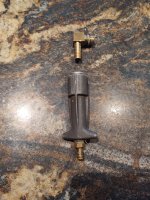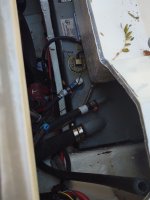harringtondav
Commander
- Joined
- May 26, 2018
- Messages
- 2,438
My new VP O/M states to run the engine on 50:1 premix for 15 min before winter layover.
Last fall I took one look at engine access and guessed on the gas in the fuel tank and premixed a rich dose in a gas can and poured into the fuel tank. I saw and smelled 2 stroke oil, so I figured good enough.
This year I'm doing it per Hoyle. Manual shows a O/B tank hose going into the filter housing. Easier in the picture than actually doing it. After disassembling a good part of the aft interior to gain access (previous post), I was able to slit the fuel hose to get it off the filter housing barb and remove the fitting.
Pic 1 shows the fitting and my Merc O/B tank hose motor coupler which I had to cut off.
Pic 2 shows my solution. I'm not in the mood to continue cutting hoses off. Since both hoses spun freely on their barbs I'll loosen the hose clamp, back out the 3/8 pipe fitting at the elbow letting it turn in the hose. Switch hoses and run 2 stoke from the O/B tank. I can access the filter housing fitting w/o disassembling the boat.
If I can find the corresponding O/B male motor gas coupler fitting next year I'll adapt it to the 3/8 pipe and simplify further.


Last fall I took one look at engine access and guessed on the gas in the fuel tank and premixed a rich dose in a gas can and poured into the fuel tank. I saw and smelled 2 stroke oil, so I figured good enough.
This year I'm doing it per Hoyle. Manual shows a O/B tank hose going into the filter housing. Easier in the picture than actually doing it. After disassembling a good part of the aft interior to gain access (previous post), I was able to slit the fuel hose to get it off the filter housing barb and remove the fitting.
Pic 1 shows the fitting and my Merc O/B tank hose motor coupler which I had to cut off.
Pic 2 shows my solution. I'm not in the mood to continue cutting hoses off. Since both hoses spun freely on their barbs I'll loosen the hose clamp, back out the 3/8 pipe fitting at the elbow letting it turn in the hose. Switch hoses and run 2 stoke from the O/B tank. I can access the filter housing fitting w/o disassembling the boat.
If I can find the corresponding O/B male motor gas coupler fitting next year I'll adapt it to the 3/8 pipe and simplify further.






















